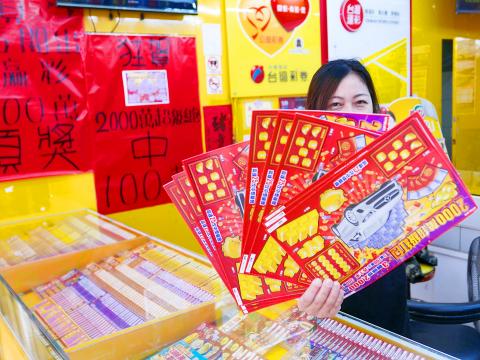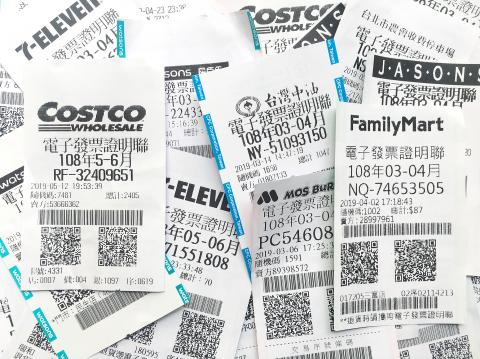Winning ticket holders of Taiwan Lottery or the Unified Invoice Lottery, as the system currently stands, have to pay 20 percent income tax on winnings worth NT$2,000 and above. As the threshold has existed unchanged for over 40 years, Democratic Progressive Party Legislator Shih Yi-fang has proposed a bill raising the threshold to NT$5,000. In response, Minister of Finance Su Jain-rong has promised to conduct a review and issue a report within the next three months. The ministry is expected to issue a preliminary report shortly that will detail amendments to the Standards of Withholding Rates for Various Incomes regulation. It is anticipated that this will include raising the tax-free threshold for lottery winnings from NT$2,000 to NT$5,000, coming into effect as early as December.
During a question and answer session of the Legislative Yuan’s Finance Committee in early April, Shih said that although last year Taiwan Lottery scratchcards sold like hot cakes during the Lunar New Year break, due to the 20 percent tax levy, a member of the public who wins a NT$2,000 prize actually only receives NT$1,600. He gave the example of someone who spends NT$4,000 to purchase two NT$2,000 Taiwan Lottery tickets: one of the tickets wins a NT$5,000 prize, but after income tax is deducted at 20 percent — leaving NT$4,000 — and a further NT$20 of stamp duty is paid, the person is actually out of pocket by NT$20.
Shih believes that since the Standards of Withholding Rates for Various Incomes has remained unchanged since 1979, an adjustment is now due. According to data from the Directorate-General of Budget, Accounting and Statistics, in 1979 NT$2,000 was worth NT$4,968 in today’s money. Shih says the ministry should therefore move with the times and raise the tax-free threshold for lottery winnings from NT$2,000 to NT$5,000.

Photo: Tsai Shu-yuan, Liberty Times
照片:自由時報記蔡淑媛
Ministry officials say that the changes will not come into effect until December due to the requirement for a communication period, and because businesses may need to make adjustments to their systems
(Translated by Edward Jones, Taipei Times)
目前彩券或統一發票中獎獎金超過兩千元就要課徵所得稅百分之二十,由於課稅門檻已超過四十年未修正,民進黨立委施義芳提案,將課稅門檻提高至五千元,財政部長蘇建榮當時允諾三個月內提出檢討報告。據了解,財政部近期將預告修正「各類所得扣繳率標準」,將中獎獎金免稅門檻從兩千元提高到五千元,最快十二月上路。

Photo: Cheng Chi-fang, Liberty Times
照片:自由時報記者鄭琪芳
施義芳四月初於立法院財政委員會質詢表示,過年期間刮刮樂賣得非常好,但民眾中獎兩千元就要課稅百分之二十,等於實領一千六百元;若花四千元買兩張兩千元刮刮樂,一張中了五千元,扣掉百分之二十所得稅加上二十元印花稅,還要倒賠二十元。
施義芳認為,「各類所得扣繳率標準」自一九七九年沿用至今,已超過四十年,應有所調整;據主計總處試算系統,一九七九年的兩千元等於今年的四千九百六十八元,財政部應順應時局將中獎獎金免稅門檻從兩千元調高至五千元。
財政部官員表示,由於修正後仍要一段宣導期,且業者系統可能要調整,因此預計今年十二月才會上路。
(自由時報記者巫其倫)
FOLLOW UP
讀後練習
Are you sitting on a winning ticket?
中獎人是你嗎?
Don’t pass up a lucky encounter with the God of Wealth. Although the winning numbers for March and April’s Unified Invoice Lottery were released on May 25, there are still unclaimed invoices out there for the Jan-Feb period. The invoices in question, with the number 00106725, are for the NT$10 million (approx. US$318,000) special draw, and were among 20 winning invoices. For the Jan-Feb period there are currently a total of five unclaimed invoices, including one obtained after purchasing three Taiwan Railways boxed lunches.
The Ministry of Finance says that for the Jan-Feb period there was an unprecedented number of 20 winning invoices for the Unified Invoice Lottery. Five of the unclaimed invoices are for the NT$10 million jackpot, while three are worth NT$2 million. The deadline to claim winning invoices from January and February is July 5 and the ministry urges anyone with a winning invoice to quickly claim their prize.
(Translated by Edward Jones, Taipei Times)
別和財神爺擦身而過!三至四月期統一發票五月二十五日開獎,但一至二月期中獎統一發票獎金仍有人未領,一至二月期統一發票一千萬元特別獎,中獎號碼為「00106725」,中獎張數共計二十張,目前仍有五張還沒有兌領,其中包括一張僅買了三個台鐵便當,就中了千萬大獎。
財政部指出,今年一至二月期統一發票,中獎張數破紀錄達二十張,為史上最多。至今仍有五張千萬中獎發票、三張兩百萬中獎發票未領,一至二月統一發票領獎期限至七月五日,呼籲中獎者盡快兌領。
(自由時報記者巫其倫)

Stonefish may not be the most impressive-looking animal in the sea. In fact, this fish is so skilled at camouflage that most people wouldn’t notice it if they swam past it. Despite their unremarkable appearance, stonefish are the most venomous fish in the ocean. Stonefish come in various shades of brown, red, yellow, and orange. Their rough skin texture and blotchy color pattern give them a remarkable resemblance to stones, which is where their name comes from. This feature helps them blend in with their surroundings exceptionally well. Stonefish are notable for their 13 highly venomous spines which protrude

Renhe sat stiffly at the Wei Ya banquet, picking at the symbolic dishes on the table. Fish for abundance, sticky rice cake for progress — it all seemed superstitious to him. The shrine to the Land God near the entrance, adorned with offerings, incense, and fruit, struck him as frivolous. “What does this have to do with running a business?” Renhe scrolled on his phone as his co-workers performed skits and poorly sung songs. He wasn’t even paying attention to the lucky draws when his name was called. The room filled with applause and cheers as he went to the stage

「雙手合十/合掌禮」(namaste) or 「碰肘/擊肘」 (elbow bump): 新冠肺炎流行逐漸改變現代社會的某些社交禮儀,歐美許多名人政要開始以「雙手合十/合掌禮」(namaste) 或「碰肘/擊肘」(elbow bump) 替代握手。 《今日商業》報導英國王儲查爾斯以「雙手合十」代替握手。 Coronavirus update: Prince Charles spotted greeting people with namaste (Business Today , March 12, 2020) 另外,《商業內幕》報導:疫情期間美國總統川普在白宮舉行新冠肺炎記者會,想和居家照護公司LHC集團執行副總葛林斯坦 (Bruce Greenstein) 握手,葛林斯坦婉拒,示意改用擊肘。 President Donald Trump attempted to shake hands with a home health care company executive . . . but the man turned the president down and offered him an elbow bump instead. (Eliza Relman, Business Insider , March 14, 2020) 「雙手合十/合掌禮」源自印度,也流行於泰、緬等國家。「碰肘/擊肘」則是 2006 禽流感、2009 豬流感後逐漸流行。疫情逐漸改變我們的生活方式,包括打招呼等社交禮儀,也出現了微妙的變化。 「拱手禮」(fist-and-palm salute) 至於華人社會傳統上也有雙手互握合於胸前「拱手禮」(fist-and-palm salute)。公益網站 Just Quarantine 提到: Taiwanese president Tsai Ing-wen demonstrating social distancing through use of a traditional Chinese greeting (fist & palm) instead of shaking hands in response to the COVID-19 pandemic. 因應新冠肺炎疫情,2020 當年總統蔡英文與來訪賓客保持安全距離,拱手 (fist &

Continued from yesterday(延續自昨日) https://www.taipeitimes.com/News/lang Interestingly, stonefish don’t use their venomous spines to hunt. Instead, the spines serve as a defense mechanism. When hunting, stonefish catch their prey by hiding among rocks on the seafloor or in coral and remaining incredibly still until small fish or shrimp swim by. They then ambush their prey with lightning speed, swallowing their meal in a second. Despite their quick movements when capturing prey, stonefish are generally slow swimmers. They prefer to stay in shallow waters rather than swim in open areas. They can even survive outside of water for up to 24 hours. So,